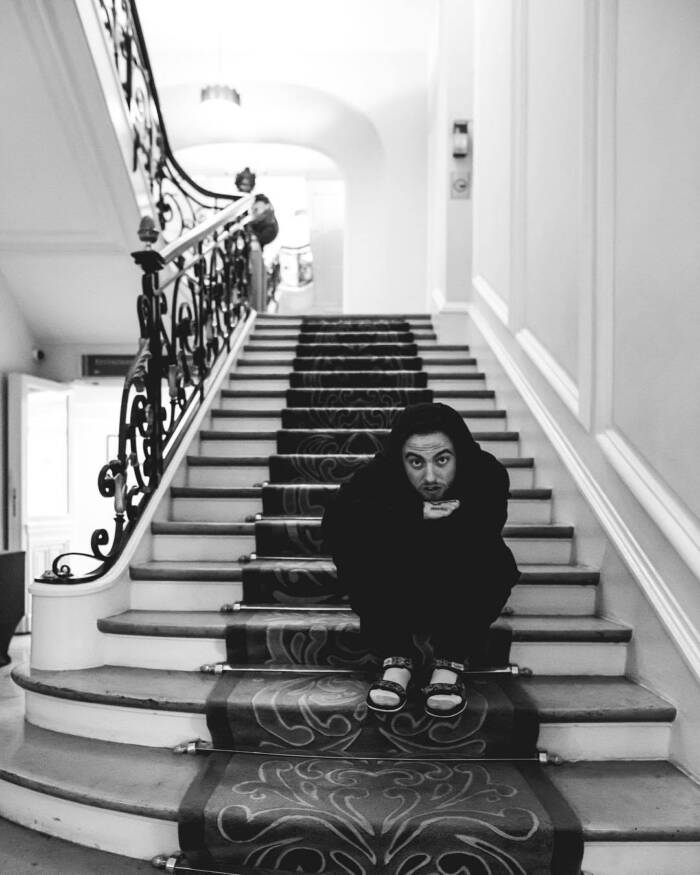After a long battle with substance abuse, 26-year-old Mac Miller died of an accidental overdose of fentanyl, cocaine, and alcohol on September 7, 2018.

The Photo Access/Alamy Stock PhotoRapper Mac Miller was found dead at his Los Angeles home on September 7, 2018.
“I want to be, like, Beatles big, when it’s all said and done. I want to change what’s on the radio.”
It was a lofty goal for anyone, let alone a kid who grew up in Point Breeze, a small neighborhood on the outskirts of Pittsburgh, Pennsylvania. But for Malcolm James McCormick, better known as Mac Miller, it was a goal well within his reach. He was a self-taught musician, able to play piano, guitar, drums, and bass by the age of six. By 15, he had put out his first mixtape.
Mac Miller drew inspiration from numerous genres of music, and those influences were clear in the songs he produced. He eventually became an international success, working with popular artists like Schoolboy Q, Thundercat, Tyler, The Creator, and Ariana Grande (who he also dated).
Unfortunately, Miller also publicly struggled with substance abuse and depression. Amidst his rise to fame, he admitted to being addicted to lean — a recreational drug made by combining prescription-strength cough syrup and a soft drink — and these struggles followed him throughout his career. Although he attempted sobriety, he never managed to kick his old habits.
This came back to haunt him on Sept. 7, 2018, when Mac Miller was found dead in a “praying position” in his home in Los Angeles. A bottle of prescription pills, an empty bottle of alcohol, and a $20 bill with white residue were found near the 26-year-old’s body. His loved ones and fans were heartbroken, especially when they learned how Mac Miller died. Miller’s death was ruled an accidental overdose of fentanyl, cocaine, and alcohol.
Three men were later convicted for their roles in providing Miller with fentanyl-laced drugs, but even with justice served, there was no denying that Mac Miller’s death was a tragedy in the truest sense of the word.
Mac Miller’s Early Life And Rise To Fame

Mac Miller/FacebookA childhood photograph of Mac Miller, posted to his Facebook page with the caption, “Safety First.”
Born Malcolm James McCormick on Jan. 19, 1992, Mac Miller grew up in the Point Breeze neighborhood of Pittsburgh, Pennsylvania. He was the son of photographer Karen Meyers and architect Mark McCormick.
He had a brother named Miller McCormick, and the two boys were raised Jewish, though they would end up attending a Catholic school to ensure “a good education and the chance to play football and lacrosse,” as Mac Miller later explained during an interview with Billboard.
After grade school, Mac Miller attended Taylor Allderdice High School — the same school fellow Pittsburgh rapper Wiz Khalifa attended. But school was never really Miller’s focus. He cared more about making music, learning how to play several instruments on his own by the time he was six.
Although he originally wanted to be a singer, by his early teens, his main focus had shifted to rap. “The thing about Pittsburgh is, if you can’t rap, no one likes you,” Miller told the Pittsburgh City Paper in 2011. “You can’t get by doing the minimum. For me, it was never about being the young kid who was trying to rap. It was about rapping better than anyone else.”
Evidently, Miller’s skills showed that he could walk the walk. By the time he was 15 years old, he was already an up-and-comer in the Pittsburgh rap scene. At 16, he played his first show at a local bar called Moondog’s.

Mac Miller/FacebookRapper Mac Miller delighted countless audiences across the world before his untimely death in 2018.
Of course, since he and his friends were so young at the time, Miller said, “My homies couldn’t even get in to see me. The shows we used to do, you basically perform for other rappers and their friends… I think I’ve performed for two people before. Like, literally, two people.”
Still, his name was making the rounds online, even outside of the local Pittsburgh scene. Then, in March 2011, Miller released the mixtape Best Day Ever, which proved to be an overnight success. In the first weekend alone, it had been downloaded more than 200,000 times.
However, Miller wasn’t known as a radio-friendly artist. He built his following largely online, and it reached the audience it was meant to reach. This made it difficult for the average person to categorize him. Some tried to label him a “frat rapper,” and others tried to dismiss his music as bubble-gum pop. For Miller, though, the music he wrote was just the music he wrote.
“I just make music that’s hip-hop,” he explained. “I’m not here to be a teenybopper sensation. I make music because I love making music. So whoever wants to love it, that’s who I want as my fans.”
But there was no doubt that when he released his debut studio album, Blue Slide Park, in November 2011, he was destined for greatness.
Rising Fame, Substance Abuse, And Mental Health Struggles

YouTubeMac Miller in the music video for his song “Donald Trump,” released in 2011 when Trump was not yet the U.S. president.
Blue Slide Park quickly soared to the top of the charts, but while it was a hit with Miller’s fans, critics weren’t as kind. In a 2013 interview with Complex, Miller described the album’s critical reviews as “horrible.”
“A lot of the reviews were more on me as a person,” he said. “To be honest, that was even worse. You’re 19, you’re so excited to put out your first album, you put it out — and no one has any respect for you or for what you did.”
Pitchfork gave Blue Slide Park the low score of 1.0, adding, “Unless you buy into Miller’s persona — and why would you? — Blue Slide Park offers you nothing that you can’t find done more much artfully by, say, Curren$y.”
Then, when Miller kicked off the Macadelic Tour in 2012, he only managed to book shows at colleges for the first leg of it. Critics continued to label him as a “frat rapper,” effectively saying that he only made boyish party anthems.
This, combined with the stress of touring, took a toll on Mac Miller, and he turned to drugs to cope — a habit that would later lead to his early death.
“I love lean; it’s great,” he said in the 2013 Complex interview. “I was not happy and I was on lean very heavy. I was so f**ked up all the time. It was bad. My friends couldn’t even look at me the same. I was lost.”
Lean, also called “purple drank” or “sizzurp,” is a combination of prescription cough syrup and soda, sometimes with hard candy mixed in. Strong cough medication usually has some sort of opioid and antihistamine in it, which can produce mild euphoric side effects — and it carries a risk of addiction. In Miller’s case, he was often mixing codeine and promethazine in his lean.

Mac Miller/FacebookIn his later songs, Mac Miller often touched on themes of substance abuse, depression, and death. In one song, Miller said he hoped not to join the 27 Club, making his early death at 26 even more tragic.
“He had sort of made a turn after the making of Blue Slide Park, where I think he got a little bit deeper into drugs and was talking about it,” Benjy Grinberg, the founder of the independent Pittsburgh record label Rostrum Records, who signed Miller in 2010, told Rolling Stone. “It was definitely scary. I had never been that close to somebody who had issues like that.”
Around the same time, Miller was hit with a $10 million lawsuit from Lord Finesse, due to Miller’s sampling of a beat from Finesse’s 1995 song “Hip 2 Da Game” in his own 2010 track “Kool Aid and Frozen Pizza.” Miller had released the track for free on a mixtape, but the lawsuit argued that it helped to propel his career — and that he needed to pay up. The ongoing stress of the situation only made Miller fall further into addiction.
Friends urged him to quit lean, and to their surprise, he did. His childhood friend Jimmy Murton even went so far as to say that quitting lean was “one of the most impressive things [Miller’s] ever done.”
Meanwhile, Miller was trying to put together a sophomore album.

ZUMA Press, Inc./Alamy Stock PhotoMac Miller at the Rock in Rio Lisboa 2014 music festival in Portugal, four years before his death. Many of Mac Miller’s fans were heartbroken when they learned how he died, but not necessarily surprised, considering his battle with addiction.
By his own estimation, he had recorded around 400 songs, likely determined to prove to critics that they had been wrong about him. But it was a difficult process, and as a way of unwinding, Miller also recorded and released a jazz EP titled You under the alias Larry Lovestein & The Velvet Revival.
The experience was cathartic. When the EP was finished, Miller was like a new man, and the pressure of producing a commercial success started to fade as he found excitement in making new types of art.
Of course, that didn’t stop him from making hits. He put out a second studio album, Watching Movies with the Sound Off, in 2013 to generally favorable reviews. That same year, he received a key to the city of Pittsburgh.
In January 2014, his contract with Rostrum Records expired and Miller parted ways with the label. That May, he put out the mixtape Faces, which was seen as his most introspective work to date. It also happened to come at a time when Miller was deep in the throes of drug use. “I was not on planet earth when I made Faces. Nowhere close,” he later posted on his Twitter page.
His music continued to evolve, and his list of collaborators continued to grow. By 2016, he was living in Los Angeles with his friends, dating singer Ariana Grande, and producing several records that blurred genre lines. He was 24 and living a very different life from the one he’d had back home.
He was also sober and clean.

Mac Miller/FacebookMac Miller and Ariana Grande in their Halloween costumes.
“The idea of being 100 percent clear-headed was something I realized I had never done,” he said in an interview with Nylon. “As soon as I felt what it felt like to wake up every day and feel good every morning, I realized how important that was for me. You can do so much with a day… As soon as I learned that I could do things creatively sober, then it was good.”
That sober period didn’t last, though. A year later, he told W Magazine, “I’ve spent a good time very sober and now I’m just, like, living regularly. I think it’s important. I don’t believe in absolute anything… But it was important to let everyone know that I wasn’t doing f**king crazy amounts of hard drugs.”
But that was when things were going relatively well for Miller. Another year later, in 2018, however, things weren’t going so well — and they only went from bad to worse, paving the way for Mac Miller’s untimely death.
A Public Breakup With Ariana Grande And An Arrest For DUI

Beats 1Mac Miller during an interview with Zane Lowe following his DUI arrest.
In May 2018, after dating for about two years, Mac Miller and Ariana Grande announced that they had split up. Later that same month, Miller crashed his Mercedes-Benz G-Wagon into a power pole in the San Fernando Valley, after which he and two friends ditched the car and fled the scene. Miller was arrested shortly thereafter and charged with DUI and hit-and-run.
He later touched on the infamous incident during an interview with Zane Lowe on Beats 1 in July, acknowledging what he had done:
“What you don’t understand is that I lived a certain life for 10 years and faced almost no real consequence at all. No version of the story that didn’t end up with me being fine. I made a stupid mistake. I’m a human being, like, drove home drunk. But it was the best thing that could have happened… I needed that. I needed to run into that light pole and literally like, have the whole thing stop.”
A month later, though, Miller seemed to be doing better. He sat down with Rolling Stone and clarified that while he had made a mistake driving that night, his heavy drug use was still a thing of the past. He also released the album Swimming that month, which contained several references to his mental health struggles over the years. Some of his new music sparked concern among fans, as his songs seemed darker than ever before.
He later elaborated more on his depression, speaking with Vulture that same month. “I don’t want to be depressed,” Miller said in the interview. “I want to be able to have good days and bad days… I can’t imagine not waking up sometimes and being like, ‘I don’t feel like doing sh*t.’ And then having days where you wake up and you feel on top of the world.”
Swimming had just been released, but already Miller was back in the studio working on new music. He was also getting ready to go on tour with Thundercat, who said that period was “nothing short of pure excitement.”

NPR/YouTubeThundercat and Mac Miller performing during NPR’s Tiny Desk Concerts series.
“The happiness was there, man,” Thundercat recalled. “I could see it in him.”
Unfortunately, this promising period ended in the most tragic way anyone could have imagined — with Mac Miller’s death at age 26.
How Did Mac Miller Die? Inside His Overdose

ZUMA Press, Inc./Alamy Stock PhotoAfter Mac Miller’s death, a vigil was held for him at Frick Park’s Blue Slide playground, the namesake of his debut album.
At about 11:30 a.m. on Sept. 7, 2018, 26-year-old Mac Miller was found dead in his Los Angeles home by his personal assistant. Miller was reportedly kneeling on his bed in a “praying position” and was completely unresponsive. Though the assistant quickly called 911 and performed CPR on Miller, neither the assistant nor the paramedics who arrived were able to save the rapper.
Miller was pronounced dead just 16 minutes after the 911 call. Near his body was a bottle of prescription pills, an empty bottle of alcohol, and a $20 bill with white residue, offering tragic clues about how Mac Miller died.
In November 2018, an autopsy report released by the Los Angeles County coroner explained how Mac Miller had died. According to the autopsy, he perished due to an accidental overdose caused by a combination of cocaine, alcohol, and fentanyl. The report also made a note that this was one of many frequent “slip-ups” Miller had during his attempts at sobriety.
According to the assistant who found the body, one of those “slip-ups” had occurred just three days before Mac Miller’s death.

Mac Miller/FacebookProsecutors later said that Mac Miller was likely unaware that the counterfeit oxycodone pills he was taking had been laced with fentanyl — adding another tragic layer to how he died.
According to prosecutors, the tragedy wasn’t just that Miller had broken his sobriety once again, though — it was that he likely had no idea the counterfeit oxycodone pills he was taking were laced with fentanyl. So where did the fentanyl-laced pills come from, and who gave them to Miller?
The answer came later on, after a police investigation and subsequent trials. In 2019, three people were arrested in connection with Mac Miller’s death: Cameron Pettit, Stephen Walter, and Ryan Reavis. All three of them had previously been charged with drug-related offenses, though it wasn’t immediately clear how they were connected to Miller’s demise.
In 2022, Rolling Stone reported that Walter initially agreed to a plea deal of 17 years, but a judge rejected the plea deal, saying, “I may as well lay it out, okay. When you continue to engage in this activity even after your activities killed someone, I’m having a tough time not staying within the guidelines.”
So, what happened?

ZUMA Press, Inc./Alamy Stock PhotoTo this day, Mac Miller’s fans and loved ones are haunted by how he died.
Walter claimed that he told Reavis to deliver the pills to Pettit, believing that Pettit was going to be the one taking the pills. “He never told me anything about McCormick [Miller’s real last name],” Walter said. “He didn’t tell me he was going to deliver those pills to another person… He was experienced [in] using those pills. I thought it was for him — for personal use. And then he delivered them to McCormick with cocaine and Xanax, or whatever.”
Assuming this narrative is correct, Walter first gave the pills to Reavis, then Reavis gave the pills to Pettit, and then Pettit gave the pills to Miller. Tragically, these pills were directly tied to how Mac Miller died.
In the end, Walter was sentenced to 17.5 years in prison, Reavis was sentenced to 10 years and 11 months in prison, and Pettit served an unknown sentence, ending when he was released in 2024. (Some have speculated that Pettit cooperated the most with law enforcement, potentially explaining why his sentence didn’t last as long.)
During the trials, Miller’s grieving mother, Karen Meyers, delivered a heartbreaking statement. “My life went dark the moment Malcolm left this world,” she said. “Malcolm was my person, more than a son. We had a bond and kinship that was deep and special and irreplaceable. We spoke nearly every day about everything — his life, plans, music, dreams. He would never knowingly take a pill with fentanyl, ever. He wanted to live, and was excited about the future. The hole in my heart will always be there.”
After reading about how Mac Miller died, read the full stories behind the tragic deaths of Heath Ledger and Freddie Mercury.





